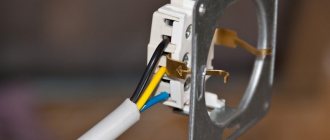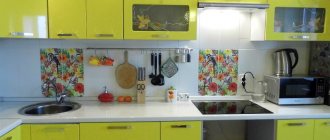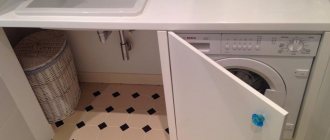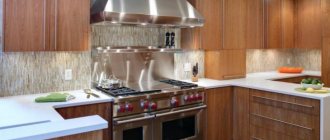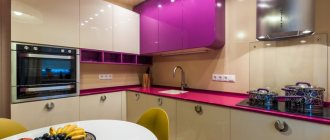Kitchen household appliances are divided into stationary and non-stationary. Stationary equipment is considered to be one with a permanent parking place, for example, a stove, refrigerator, microwave or kettle - kitchen aids that are used every day.
Non-stationary equipment is one that is used periodically and most of the time is stored in a closet, for example, a food processor or meat grinder.
IMPORTANT! The following are permanently located on the kitchen countertop: a kettle, a coffee maker, a toaster and a multicooker (chosen as an example) - each of them needs a separate socket, and for temporarily used appliances, one or two additional electric points are enough; it is unlikely that anyone will use a blender or meat grinder at the same time , electric kebab maker and deep fryer.
Selection and number of sockets
More details about the types and required number of sockets were written in this article. It should be borne in mind that ill-thought-out nuances can cause a lot of inconvenience during the subsequent operation of the kitchen. Ideally, it is necessary to provide sockets for basic devices and equipment:
- fridge;
- microwave;
- oven;
- dishwasher;
- washing machine;
- hob;
- exhaust ventilation;
- electric kettle, mixer, toaster, etc.;
- TV;
- air conditioner;
- electric heated floor.
Even if the use of some household appliances is in question or they are not yet physically available, it is much easier to lay wiring under them than to then look for a place to connect them and pull tens of meters of extension cords. In addition, it would be useful to provide one or two auxiliary (backup) sockets in case of connecting a lamp, garland, laptop, etc.
How to determine the quantity?
The number of sockets will never be universal; in this matter, it is worth starting from the number of household and electrical appliances in the kitchen. However, for reasons of functionality, it is worth placing at least three sockets on the apron. It is optimal to install two or three nesting models in several places.
Important! Separate power outlets must be provided for the hob, oven, hood or sink.
It is permissible to connect several low-power devices to one source.
Distances and layout of sockets
When drawing up a diagram, it is worth first deciding where the electrical appliances will be installed. Based on practice, as well as the standards for manufacturing kitchen furniture, a three-level layout of sockets has emerged. Each level corresponds to a specific type of equipment:
- First (bottom). Corresponds to the location of sockets at a height of 100-150 mm from the floor; large-sized appliances are connected to it, as well as for built-in appliances that are not planned to be turned off frequently. It is not recommended to install lower; heating, sewer and water supply pipes are usually laid below. It is better to make such connections in blocks of 2-3 places per terminal with a cable with a cross-section of 4-6 mm, or you can make a power socket with two terminals for powerful consumers. It is better to choose internal models with closing lids. If the nest is not in use, it is simply closed with a lid, which also increases safety by protecting the pads from debris and insects.
- Average level. Corresponds to the placement of sockets on the apron at a height of 110-120 cm from the floor (100-150 mm above the table surface), it is intended for small household appliances - a kettle, mixer, food processor or toaster. These dimensions are dictated by the fact that the height of the desktop surface is 80 cm, approximately 10-15 cm is required in order to protect the connector from water and splashes. The socket can be arranged in blocks of 3-4 connectors. It is better to use recessed mounting boxes, and place the connectors themselves in one row - using plugs with a side cable entry, it is very inconvenient to plug the plugs into sockets located one above the other.
Arrangement of sockets in three levels
On the upper tier (1.9-2 m from the floor), sockets are installed for non-standard connections in the form of an air conditioner, hood or boiler installed under the ceiling; an open type of cable routing in a cable duct and overhead socket models can be used.
A separate cable is allocated for the stove; this device consumes the most energy. It is permissible to connect a washing machine and a dishwasher in one line to a 20-amp machine if their total power is no more than 4 kW. However, it is not recommended to turn on the machines at the same time.
The distribution of connection points in three lines simplifies installation. For each level, cables of different sections are installed and connected to separate machines.
Instructions for determining the size of the apron and cutouts for sockets
- When installing sockets in the kitchen on the apron, an installation height of 10-30 cm above the worktop is allowed. At the same time, it is undesirable to take the minimum possible height, since the table surface is often filled with dishes, food and small household appliances, which makes access to sockets problematic.
How to treat the surface → Room decoration → How to choose the right paint → Surface treatment technologies → Leveling and finishing the walls → Selecting and applying a primer → Removal from the surface → Stretch ceilings and technologies → Reviews and testimonials
What should be the distance and height of sockets in the kitchen?
When drawing up a plan for connection points, it is necessary to take into account the configuration of the headset, which will allow you to choose the optimal locations for their installation. You need to start work by installing large-sized equipment, which will always be in one place. After this, areas of additional sockets for all other devices are marked.
For oven and hob
These two types of equipment are connected via two independent wiring. The sockets are distributed as follows - at a distance of 20 centimeters from the floor level or the side surface of the device.
If the oven is installed separately at a height of 120 centimeters, then the sockets should also be at this mark. The ideal camouflage option would be to place it in a locker. The connection point is located at a height of 60 centimeters from the floor.
For refrigerator
According to the manufacturer's instructions, the refrigerator cannot be connected via an extension cord. The wire of this equipment is small - up to 1 meter, so the connection point should be located nearby. According to regulations, the device must be placed at a height of 20-70 centimeters from the floor level and 20 centimeters from the side wall of the device. If the connection point is not provided according to the diagram, it is necessary to make a groove in the wall and connect the cable.
Installation nuances for a washing machine and dishwasher
These two household appliances are installed in close proximity to the sink. It is best to hide such equipment in a special cabinet that will protect their body from the destructive effects of corrosion. The connection point for the washing machine and dishwasher is installed at a distance of 20-40 centimeters from the floor level and 10-20 centimeters from the side wall of the equipment.
For microwave oven and coffee machine
The coffee maker and microwave oven must also be plugged in. The microwave oven is installed on the countertop. The coffee machine can be placed on the microwave; for such household appliances, a double energy consumption product can be provided.
For hood
The best installation method is to mount the device on a wall or in a cabinet. In this case, you need to retreat 15-20 centimeters from the pipe. Some models of ventilation devices are connected directly to the electrical terminals (this applies to open hoods).
Work area lighting
In addition to connecting equipment to sockets, a very important point is the lighting of the apron and the power supply to it.
Additional light is designed in accordance with certain requirements, namely clause 2.12 of VSN 59–88. It must be at least 200 lux, and a similar requirement applies to washbasin lighting. The main lighting in the kitchen should be 100 lux.
It is possible to implement lighting using different methods, especially since there are any options available for sale to suit the client’s tastes and stylistic requirements.
The most common solutions include:
- installation of an additional lamp on the wall. In this case, you can use incandescent lamps, conventional or fluorescent lamps, and others. The implementation of this is quite simple, but the appearance is not very aesthetic. According to the PUE, protective glass must be provided for incandescent lamps, and installation must be done above tables. For luminescent types, gratings are used;
- use of corner lamps. The option is more attractive and interesting; fluorescent lamps, which are placed one part against the wall and the other on the bottom of the wall cabinet, are more suitable for the look. Due to the implementation, it is possible to disguise the lamp;
- installation of spotlights. They are mounted in wall cabinets and often use devices with a 12V direction, so you need to additionally buy a converter and install them outside the furniture;
- use of apron lighting. This option is the most optimal, beautiful and is implemented with the additional use of glass. Any craftsman knows how to make furniture with lighting; the choice is ideal in terms of efficiency and appearance, but cost is the main disadvantage.
Naturally, lighting sockets must be made so that they are invisible to the eye. It is best to mount them above or behind wall cabinets, but in this case you will need to cut a niche in the back wall to access the network and connect the plug.
Which cable to use
The laying of power supply cables is planned based on the power of household appliances:
- Copper cable with a conductor cross-section of 8 square meters. mm is planned to provide individual high-power consumers - electric stove, hob, electric oven, heating boiler, storage water heater, instantaneous water heater, automatic washing machine, dishwasher;
- Copper cable with a cross-section of 4-6 sq. mm - microwave, refrigerator, electric kettle, food processor;
- Copper cable with a conductor cross-section of 2-4 mm - for a toaster, blender, electric meat grinder, coffee maker, coffee machine, TV and other consumers.
If installing a block of sockets, it is recommended to lay a separate line to the block from a cable with a cross-section of 6-8 mm, this will ensure reliable operation without overheating the line.
copper cable VVGng
Installing separate lines to high-power consumers will ensure a reliable supply of electricity to the device and emergency shutdown by a circuit breaker. For example, if the heating element of a washing machine fails and there is a short circuit in the circuit, an individual machine will turn off only the power line of the washing machine. And the rest of the devices will continue to operate as normal.
Attention! When laying new wiring, you need to use only copper cable, no twists with aluminum, only solid wires from the machine on the panel to the kitchen outlet!
Preparing for installation
Before installing sockets, it is recommended to make markings on the wall.
The beginning of the kitchen electrification process is drawing up a project, carrying out calculations and purchasing everything necessary.
For work you will need the following tools and materials:
- hammer drill, grinder, soldering iron;
- pliers, wire cutters, knife;
- screwdrivers;
- roulette, level;
- copper cable VVGng-Ls 3×4mm²;
- spatula, putty;
- corrugated plastic tube.
Drilling tiles for a socket.
Preparation of the base is carried out in the following sequence:
- Markings are applied to the walls. Lines are made only in the vertical and horizontal directions. The places where sockets and mounting boxes will be located are marked.
- Using a grinder and a hammer drill, grooves and holes are made for the glasses.
- Plastic tubes with a cable pre-stretched inside are placed in the grooves. After this, the grooves are sealed with putty.
You can continue working after the solution has completely set. To avoid subsequent stripping, the solution must be laid so that it does not form a convex layer after hardening.
Schemes for placing sockets in the kitchen
Due to the likelihood of switching high currents, it is recommended to install several groups of sockets equipped with individual wiring and a circuit breaker.
Based on the installation locations of the equipment in the kitchen, you should develop a diagram that will allow you to correctly place sockets and calculate the number in each block.
To create a socket installation diagram you must:
- Draw a floor plan and schematically arrange furniture and energy consumers.
- Mark the places where to put the sockets.
- Determine quantity. For the calculation, it is recommended to use the rule - each stationary unit of equipment requires an individual socket, plus the installation of spare units for 2-3 places is required. The blocks are placed near the end surfaces of the kitchen countertop and one block is placed near the dining table.
- Provide an additional outlet located next to the light switch.
- Plan to install two backsplash outlet blocks that are located in areas on the sides of the stove or hob. The blocks consist of 2-3 sockets.
- Determine the installation distance from the floor and equipment. To do this, draw a scan of the walls with installed furniture. At this stage, it is necessary to make accurate measurements of the room, stationary household appliances and elements of the kitchen set.
One of the options for installing sockets
Recommendations for wiring and circuit breakers
- for a group of sockets into which devices up to 3.5 kW are connected, a 16A circuit breaker is installed
- for devices up to 5.5 kW automatic 25A. Moreover, it is better to extend a separate group to this pantograph
You can also navigate using the following table for selecting machines and cables when connecting a hob:
- since the kitchen is a wet room, plus a huge number of objects with a metal case, it is mandatory to install an incoming RCD with a current of 30 mA in the panel in front of all machines
- all sockets must have a grounding contact, for a rated current of up to 16A, for hidden wiring
- A separate socket is installed for each pantograph
- do not use carriers or extension cords in the kitchen
This is not only an additional load on the wiring, but also a potential short circuit (due to spilled tea or other liquid).
Preparatory work
The glass itself has a number of positive aspects, but during installation it is necessary to take into account all the subtleties, including holes for installing sockets. If you do not cut them out in advance, then installation will be impossible in the future.
The installation process itself is almost the same for any apron material. First you need to prepare the tool and the surface itself:
- to attach the sockets you will have to work with a hammer drill, crowns and chisel;
- To conduct lines, it is recommended to use a three-core cable with double insulation, 2.5 mm in diameter, socket boxes, a distribution box, sockets themselves of 16A or more, dowels and screws.
Having decided on the amount of equipment, sockets and drawing a diagram, you need to transfer the data for electrical points directly to the wall using a pencil
It is very important to understand what a kitchen apron is made of
For installation, you need to carefully cut a hole in the tile or plywood base. The most difficult thing is with a glass work area. In this case, the apron manufacturer must be given the parameters in advance according to the diagram and location of the devices.
Laying tiles
This is a traditional kitchen solution, equally suitable for both modern and classic interiors. The material most often used is ceramics, since it combines water resistance, temperature resistance and hygiene. However, there are other options: porcelain stoneware, glass, mirror, sometimes even steel. Installation of a tiled or even mosaic kitchen backsplash follows the same principles. The difference is the wall mounting.
The photo shows a screen in the kitchen made of ceramic tiles.Work begins with measuring the area. As a rule, the apron occupies the area between the upper and lower parts of the kitchen unit, but it happens that they decide to tile the entire or almost the entire wall of the work area.
Then the required amount of material is calculated. The volume depends on the area and the method of laying: the diagonal method, for example, requires more costs. The area is prepared: the tiles are not flexible, therefore, in order to lay them correctly, a completely flat surface is required. In this case, the old finish is removed, and unevenness, if any, is leveled with a plaster mixture. The finished wall is primed with the appropriate composition. The photo shows the preparation of the wall. In order to subsequently install the sockets in the required place, it is necessary to make grooves in the wall and lay the cable. Since any tile – ceramic, and especially porcelain stoneware – weighs a lot, therefore a wooden beam or metal profile is attached to the wall along the perimeter of the future apron: the tile will rest on it and be held until the glue sets.
It is recommended, especially with little experience, to make markings by marking horizontal and sometimes vertical lines on the wall. With a complex installation method, the installation is first carried out “dry”: the tiles are placed in the required order on any horizontal surface. Tile adhesive is selected according to the material - for ceramics, for mirrors. Prepare in small portions, since the solution loses its properties after 20–30 minutes. Apply a layer of adhesive almost equal to the thickness of the tile
The best tool is a notched trowel.
Installation begins in the most visible area: it is important to ensure the maximum number of intact tiles when laying, and use cut ones along the edges of the kitchen apron. The tile is applied to the wall, slightly pressed and fixed, checked for horizontalness
The position of the fragment can be changed within 15 minutes.
After laying each row, check the surface - it must be flat. A day after installation is completed, grouting begins. Compositions based on epoxy resins are usually used: they are resistant to moisture. For sockets and switches, holes are made in the tiles with diamond core bits. Secure the sockets after the glue and grout have completely dried.
What additional materials will be needed?
To protect power supplies from splashes and soot, it is necessary to choose socket models with special plastic covers or a deep casing with protective curtains.
Today's range of power supplies for the kitchen offers 2 options:
- Internal sockets. The safest option is to cut the hole for the socket and the groove for the wire directly into the wall.
- External sockets. Relevant for houses where the wire is laid over the walls. Most often this applies to suburban wooden buildings.
“Apron design for classic kitchens”
The kitchen socket can be of various modifications:
- Have protective curtains.
- Be waterproof.
- To be supplemented with a residual current device.
- Have an ejector design, which greatly facilitates the process of pulling out the plug without displacing the mechanism of the socket itself.
- Have a built-in timer or indicator of the presence of current in the network.
For installation you will need:
- A hammer drill for forming a socket box.
- Crowns and groove chisel for laying wiring.
- Insulated electrical cable.
- Socket boxes.
- Self-tapping screws.
Also, in modern kitchens, pull-out sockets are often preferred. They are located inside an MDF apron. This design can hardly be called practical, but it certainly adds aesthetics.
“What types of aprons are there for the kitchen: a guide to design options”
When installing a retractable socket, the following 3 conditions must be observed:
- The cable must have an uninterrupted connection to the network.
- Access to the fittings should not be difficult, so that if it breaks, it can be easily replaced with a new one.
- There should be plenty of space below the surface.
Installation of MDF or chipboard panels
Installation of this kind of materials is the simplest, since wood materials are very easy to cut, process and hold fasteners. It is worth noting that in terms of durability, this option is the most impractical. You can increase the life of its use in the kitchen by choosing a material with acrylic film - it best withstands moisture and steam.
The technology for installing panel materials of this kind is the same.
- The wall is prepared in a similar way, but in this case it is necessary to use a primer with an antiseptic effect. It is very good if it is possible to attach waterproofing material.
- MDA or chipboard slabs are cut to size.
- The material can be properly fastened using self-tapping screws or liquid nails - this depends on the degree of unevenness of the wall.
- For sockets and switches, holes are cut out in advance in the panels, at the time of installation the linings are removed, and the glasses are pulled out to the thickness of the panel.
Once the work is completed, the pads are secured in place. The photo shows an MDF apron in the kitchen.
Standards for installing sockets in the kitchen
Since electricity can pose a threat to human health and life, installation work is regulated by certain rules. Most of them are reflected in regulatory documents, in accordance with which the development of projects for the electrification of residential and utility premises is carried out:
- SNiP 3.05.06 from 1985;
- GOST 7397.0 and GOST 7396.1 from 1989;
- GOST 8594 from 1980.
Here are the basic provisions that must be observed when planning electrical wiring:
- The distance from the outlet to the gas pipes should not be less than 0.5 m.
- Sockets are placed at a distance of at least 0.8 m from the water tap. Avoid steam or splashing water coming into contact with the power source.
- For an electric stove or oven, you must use special plug connectors designed for a maximum current of 32–40 A. The power line is connected directly to the panel with a separate automatic fuse.
- Sockets are not installed behind the device that they power, but are placed to the side - down or up. The distance from the power source to the device should not exceed 1 m.
- The wiring and, accordingly, all sockets installed in the kitchen must have a grounding terminal.
- Modern electrification standards require the installation of at least four sockets in the kitchen. A double design socket is counted as two single sockets.
- Electrical distribution points for small household appliances are installed at a height of 0.1 m from the workbench (or approximately 1.15 - 1.4 m from the finished floor).
- It is prohibited to place sockets above the hob or dishwasher. They should be shifted to the right or left by at least 20–25 cm.
The column with socket sockets is removed from the housing using light pressure with your fingers
The first five points are mandatory. The rest are considered more advisory. In a private apartment or house, the owner has the right to locate power sources at his own discretion and in accordance with individual needs. As a rule, the main guidelines in the arrangement of sockets are maximum ergonomics, practicality and convenience.
Step-by-step connection algorithm
In order to correctly draw conclusions for sockets, it is necessary to coordinate their location with the location of elements of the gas, plumbing and ventilation systems in order to avoid disruptions in their operation.
- The room must be de-energized.
- According to the markings, holes and recesses are arranged for socket boxes and wiring is laid to them using a hammer drill and a chisel.
- Socket boxes are installed.
- The wiring wires are laid in the grooves. Using the wire sheath and self-tapping screws, the cable is fixed in the groove.
- The socket is connected to the wiring. In this case, they find wires of the same color and connect them on one side to the outlet, and on the other - using express connection terminals to the power distribution box.
Socket boxes are installed, wires are laid in grooves - The grooves are filled with mortar, and the surface is leveled with putty.
- Connections are being checked.
- The socket is screwed on.
- The power to the room is turned on.
Rules and layout of sockets
Determine how many household appliances will be there or may appear in the near future. Then check and write down the power of each and the connection features, if any. Approximate power figures:
- Large appliances: electric oven – from 2500 W;
- hob – 1000-1500 W;
- dishwasher – from 1000 W;
- washing machine – from 1500 W;
- water heater – from 1500 W;
- refrigerator – 200-1000 W;
- freezer – 300 W.
- microwave oven – from 800 W;
- TV – 200-330 W;
The placement of sockets is subject to certain rules to prevent situations that could lead to unpleasant consequences:
Pay special attention to the fact that the total power of the devices plugged into the outlet should not exceed the permissible value. For example, you cannot connect a kettle and a microwave oven to the same outlet at the same time.
The power of devices can be clarified in their technical data sheets. It is necessary to install so many lines in the kitchen that power the sockets so that there is enough supply for all appliances with a double supply. This means that the kitchen needs to be roughly divided into parts with the location of the appliances, then the resulting power should be divided into socket groups in these parts and multiplied by two in each resulting group. For electrical appliances with high power (large household appliances, electric stoves, etc.), it is better to install separate lines with a suitable cross-section, copper and through protective automation. For convenience, it is better to sign each machine in the electrical panel. Devices with a metal body require grounding. Therefore, sockets for them must be connected through a differential circuit breaker or RCD (residual current device). It is prohibited to install sockets directly behind built-in electric ovens, refrigerators, and hoods; they should be located on the side at a distance of approximately 20 cm. Above the countertop, sockets are installed at a distance of 10-15 cm upwards. Conditions must be strictly observed to prevent moisture and splashes of grease from getting on them . Installation above a sink and stove is prohibited. When installing sockets near pipes, make sure that they have covers and rubber seals that will protect them from moisture in the event of a breakthrough.
Manufacturers indicate on the packaging for sockets what power they are designed for; these figures should be taken into account when purchasing. They produce options of 10 amperes, which corresponds to 2.2 kW, and 16 amperes – 3.5 kW.
Preliminarily draw up a diagram of the location of the sockets. This point should receive most of your attention.
The importance of this stage lies in the fact that the ease of use of household appliances in the kitchen, the safety and aesthetics of the room will depend on how accurately and successfully the diagram is drawn up
The placement of sockets should be strictly drawn on the kitchen plan and it should be noted how the electrical lines will be laid to them.
Do not forget about the design of the room; they should not spoil the overall appearance. If sockets for large household appliances, as a rule, are not visible behind the kitchen apron, then located above the countertop they can add an interesting look or ruin it.
In modern kitchens, the choice is often made in favor of pull-out options; they are hidden in the work surface without changing its aesthetics, and appear when needed. Another advantage to note is that they are easy to install; you can often order installation when making a kitchen set.
If sockets are installed before purchasing kitchen furniture
When installing a kitchen set in a room that has already been renovated, or in a room where renovation is not planned, it may be necessary to manufacture non-standard products, which will slightly increase the cost of the kitchen and complicate the project. This is due to the fact that household appliances and kitchen furniture elements have a standard range of sizes. This means that when modeling a kitchen, taking into account the location of already installed sockets, it will be necessary to “adjust” the set to the existing electrical wiring diagram.
For example, the length of the wall is 260 cm. This allows you to install in the kitchen a refrigerator (standard - 60 cm), an oven with a hob (standard - 60 cm), and a cabinet under the sink (60 cm). Subtracting the size of the standard elements (180 cm), 80 cm remains for the location of the cupboards. Please note that neither a refrigerator (to avoid overheating) nor a sink should be placed next to the hob. For the hob and sink, cutouts are made in the countertop, which must be located at a distance of at least 5 cm from each other, otherwise the countertop may crack during installation.
So, in our example, there is only one option for the arrangement of appliances and furniture: refrigerator, 40 cm cabinet, hob, 40 cm cabinet, sink. In this case, it often turns out that in the only place where you can put the oven there is already an outlet installed. The cabinet has to be moved, and in the best case, the symmetry is broken, and in the worst case, it is necessary to resort to the manufacture of non-standard products. As already mentioned, this entails an increase in the cost of the kitchen, and for many manufacturers, an increase in the production time of the set.
Thus, the best option when planning renovations in the kitchen and designing the location of electrical outlets for household appliances is to first draw up a layout of the future set, taking into account all the features of the room.
Which cable to choose for the kitchen
The next step is to calculate the cross-section of the common supply wire of the electrical panel and the outgoing wires to each pantograph in the kitchen. To buy a good cable, follow the rules below:
- if the load of devices does not exceed 3500 W - copper cables VVGng LS 3*2.25m2;
- if the load of the devices does not exceed 5500 W - copper cable VVGng LS 3*4m2;
- if the total load of all electrical appliances is up to 10,000 W - copper cable VVGng LS 3*6m2;
- if the total load of all electrical appliances is up to 15000 W - copper cable VVGng LS 3*10m.
If your home has an old grounding system (that is, there is no third protective conductor), then installing a three-conductor cable is still a suitable option. This is done to save you from replacing or reconstructing the wiring in the future.
In any case, another wire will not be superfluous. It can be useful in case of a broken cord or any other damage.
Electrical network load calculation
After drawing up the layout of the sockets, you need to calculate the load. This must be done so that at the right time, when the kitchen will be used to the maximum, there is no power outage.
Depending on the type of electrical network, the installation of machines differs. If you are on the list of lucky owners of a single-phase network, then you will need more machines. Consumers such as an induction cooker, washing machine and oven require their own line with a separate machine.
The panel should contain a common circuit breaker with maximum load. Depending on the network and consumers, its amperage may vary. No more than 5 sockets are allowed to be connected to a loop. Such a loop must be protected by a 25A circuit breaker. Typically, 32A+40A connectors are used for hobs and electric stoves. In all other cases, these are ordinary closed or open grounding sockets from 16A.
Wrong location of sockets
TOP 5 common mistakes
When performing electrical installation work with your own hands, serious mistakes are often made. Which can lead to additional costs for their elimination or expose household members to the danger of electric shock. To avoid this, let's look at the most common mistakes:
- The cross-section of the wires supplying the kitchen does not correspond to the connected load. In this case, the wiring will overheat and may fail, or even cause a fire.
- Installation of sockets before drawing up a plan for the arrangement of furniture in the kitchen. In this case, there is a high probability that some outlets will be closed and you will have to be content with fewer resources. Or install new ones after finishing the finishing work.
- The locations of the sockets are not consistent with the water pipe laying plan. Then when gating walls, drilling, etc. you can damage the pipeline and flood the room.
- The permissible socket rating does not match the equipment being connected. As a result, the device will overheat and may melt or burn out.
- The dimensions of the socket do not allow installation of the desired device or interior element.
Sockets
From a constructive and technical point of view, all sockets are divided into two groups: with and without a grounding contact. In most cases, preference is given to the first option, because the majority of modern household appliances go on sale with Euro plugs that have a grounding contact. Accordingly, their wire is three-core, having a grounding circuit.
If the renovation is carried out in an apartment of an old building, where Soviet sockets are installed, then they will have to be dismantled and removed, replacing them with new ones. In addition, instead of the old wiring, three-core cables of the appropriate cross-section are laid. Thus, the replacement process requires both time and money, and it is not as simple as it might seem at first glance.
The number of sockets is calculated taking into account units of household appliances. Take into account the fact that from year to year it becomes more and more, which will require additional devices. There are certain appliances that are always present in the kitchen: a refrigerator, a gas or electric stove, an electric kettle, an extractor hood and a microwave. The rest appear as the family's wealth increases. Therefore, when renovating your kitchen, consider which appliances you already have and which you plan to purchase in the near future.
It is worth noting that household appliances differ from each other in their power consumption. For example, a dishwasher, electric kettle or stove are very powerful units, to which a separate power supply line is supplied from the distribution board with the installation of a separate machine and RCD. This means that first the installation location of these devices is correctly determined, and only then the issue of the required installation height of the sockets is decided.
Deciding on the quantity
Calculating the total number of sockets needed for a kitchen room is not difficult. Everyone can do this on their own. It is enough to use simple arithmetic and count the number of electrical appliances used to determine how many electrical points are needed:
- Electric stove;
- Fridge;
- Water heater;
- Dishwasher;
- Hood;
- Washing machine;
- Electric kettle;
- Microwave;
- Additional devices (blender, coffee maker, juicer);
- Other components (TV, auxiliary lighting).
Having counted all the items, we add the stock; we need to increase the resulting amount by a quarter. At the same time, the cost of the work will increase, but in the future, when new devices appear, additional wiring will not be required, which is not always possible.
Basic rules for the location of sockets
To make it easier to determine where to install sockets, you need to draw a diagram on paper. It will be useful in the future. During the next repair, the drawing will help you remember where the wires should be laid on the wall. Before you start drawing up a diagram, you need to familiarize yourself with a number of basic rules for installing kitchen connectors.
How many sockets are needed?
You can determine the required number of connectors for connecting electrical appliances using the following criteria:
- all high-power household appliances must have a separate line with a connector for connection;
- hoods and kitchen furniture lighting must have separate connections;
- approximately 3 or 4 free connectors must be fixed to the kitchen apron to turn on low-power household appliances, for example, a mixer, toaster.
We've sorted out the quantity, now let's move on to determining the installation location.
Basic installation rules
There are certain rules that require compliance with the installation location of connectors for each electrical appliance:
At kitchen tables, the connectors are placed on the wall 100 mm high from the floor covering. Moreover, the distance is measured along the upper edge of the socket. Connecting built-in equipment is permitted to connectors installed behind the walls of adjacent pieces of furniture. Here you need to take into account that you will have to cut holes on the back walls of the kitchen cabinets
The height of sockets for built-in appliances is 300–600 mm. It is necessary to pay attention to the distance of the connectors from the electrical appliance. The maximum length of the wire connecting the consumer to the socket is allowed to be no more than 1.5 m. It is allowed to install sockets inside a cabinet with an installed sink, provided that the degree of protection of the connector from water corresponds to IP44. To connect the hood, the connectors are placed 500–600 mm above the cabinets
Here it is necessary to provide for the location of the air duct. It should not cover the connector, but the socket itself must be no closer than 200 mm from the center of the hood. Sockets for small electrical appliances should be installed on the apron at a height of 1–1.4 m from the floor covering. The connectors must be higher than the countertop. If furniture with lighting is used, sockets are mounted above wall cabinets. This will help hide them from view.
In addition to the basic rules, there are prohibitions. There are only 2 points:
- the socket must not be placed directly behind built-in household appliances or drawers;
- Regardless of the degree of protection, the connectors are not placed above the hob and sink.
Nowadays, kitchens are often decorated with glass aprons. It looks impressive, visually enlarges the room, and is perfectly washed from grease. Before ordering it, you must provide a drawing with the location of all sockets and the diameter of the sockets. According to this data, the manufacturer will make holes in the glass. You won't be able to cut through them yourself.
Features of accommodation
A pre-prepared diagram helps determine the number of outlets in the kitchen, their type and other features. The main placement rules are safety precautions. The main ones:
- sockets that are located at tables for preparing food should be installed at a height of 10 cm from the floor;
- the maximum length of the power cable should not exceed 1.5 m;
- when using built-in equipment, you must maintain a 1 m radius from the outlet to the equipment;
- Power supplies can be installed on the inside of the cabinets and sink;
- for the hood, the socket is placed behind the cabinet, the height from its end is 5–10 cm;
- The apron of the kitchen unit contains the main number of electrical points for connecting small appliances. The optimal height from the floor is 1–1.5 m;
- The installation of sockets above the sink and stove is strictly prohibited; they must be moved to the side at a distance of about 60 cm.
Several types of equipment can be connected to one line at once, provided their power is low. The limit of possibilities for such a source is up to approximately 3–3.5 kW.
Powerful devices are connected to separate sockets, for which a separate line is made. When purchasing, it is recommended to use electrical points with the ability to automatically turn off, which helps cut off the power in the event of a current leak.
Drilling ceramics with a tile drill bit
The special feature of this drill is its spear-shaped tip made of hard alloy, which makes the drilling process more precise. Similar drills are used when drilling holes in glass, which is known to be quite fragile.
How to make a hole in a tile? The production process consists of several nuances. To prevent the sharp edge of the drill from moving to the side, it is recommended to stick masking tape on the tile, and then mark the future hole on it with a pencil. Thanks to the tape, the drill will remain in the place where you put it, and there will be fewer chips on the tile.
Installation procedure
Connecting kitchen appliances is usually carried out at the final stage of renovating a room. This means that the finishing work has already been completed in the room, power wires have been laid, and furniture may be in place. All that remains is to figure out how to properly connect the device and what is needed for this.
In order for everything to be done correctly, it is recommended to be puzzled by the relevant issue at the initial stage of design, drawing up a communications laying diagram. At this stage, it becomes clear what kind of socket is needed, whether it will be built-in or surface-mounted, and you also need to decide on the height of its placement.
Preparatory work
First you need to determine the installation location for an electric stove or built-in hob. Ideally, you need to know the model and technical characteristics of the device. It is possible that you will need to provide a direct connection.
This means that you can do without sockets and plugs. In addition, the emphasis is on the power of the equipment, based on which the choice of fittings, wires, circuit breaker with a nominal value of 32A and an RCD with a nominal value of 40A is made.
It is best to purchase copper wire from a trusted manufacturer, then it will comply with current state standards
This point should be given special attention, since not only the longevity of the wiring and the device, but also your personal safety depends on it.
If you can’t connect the stove without an outlet, the next step is to select fittings with the required characteristics
It is important to pay attention to the rated current parameter. It is also necessary to take into account the type of installation of power accessories: for hidden installation or for open design
Accordingly, you will need to select a plug for it, unless, of course, it comes with the household appliance
It is also worth taking into account that a number of foreign-made products are incompatible with domestic sockets and may require the use of an adapter, which is advisable to avoid
Determining the installation location
In this matter, you must be guided exclusively by electrical safety rules. The dimensions of the socket should not interfere with the placement of the stove relative to the working wall.
It should not be mounted directly on the work surface or in hidden places where access to maintenance would be difficult. It is strictly forbidden to install power accessories in the following areas:
- near the location of the sink;
- next to the washing machine;
- near the dishwasher.
If the stove is installed on legs, or if the hob is built into the kitchen unit, the ideal place is at a height of 10–15 cm from the floor level. The electrical point should be kept away from water and fire. Taking into account current standards, it is better to connect the stove directly through an outlet or directly to the power cable.
Main equipment power
Before determining the installation locations for sockets and proceeding with installation, it is important to perform calculations. The first step is to register all the equipment that is planned to be used, and its approximate power.
The averages are:
- refrigerator - up to 1 kW;
- boiler - from 1.5 kW;
- hob - 1-1.5 kW;
- washing machine - 1.5 kW;
- oven - from 2.5 kW.
The data described applies to large equipment, which creates the main load. Small appliances in the form of a kettle, blender, etc. draw 300–800 W; separate places should be allocated for them in the drawing.


